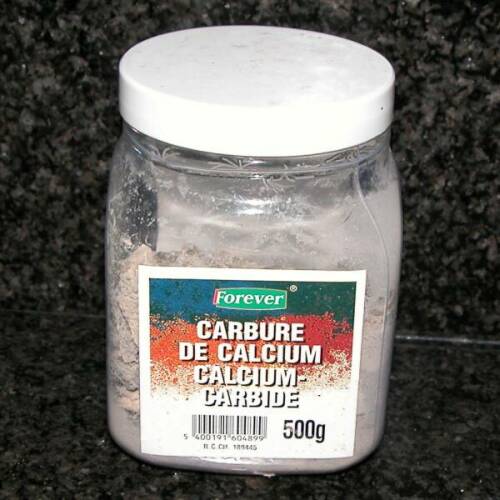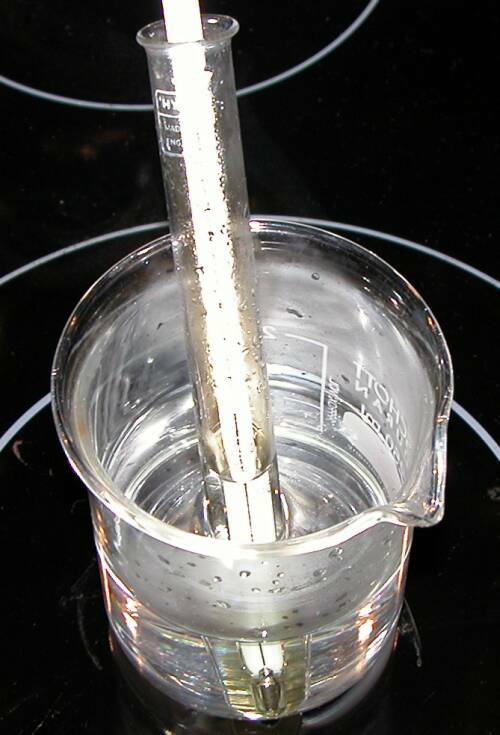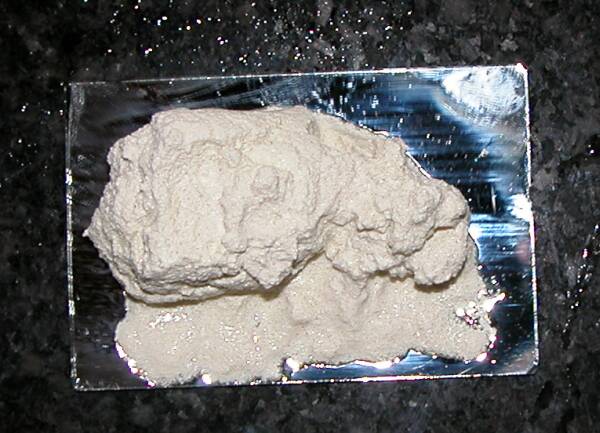In the begin-years of this site I vowed myself that I would never place a synth for a primary explosive on my site.
So why am I breaking this promise to myself?
Because in the beginning I only knew those unstable organic peroxides as primaries.
I'm not saying silver acetylide is safe, NO primary is, but that's just what we want.
An explosive sensitive enough to make deflagration to detonation transition in small quantities.
And this is just a property this explosive masters VERY well
The stuff needed for making SA:
- 2 grams of 99.999% Ag (pure silver)
- 5 ml of 65% HNO3 (nitric acid)
- a source of H2C2 (acetylene)
- Distilled water
- Gloves to handle anything contaminated with AgNO3 solution.
(normal latex will do)



From left to right: the 2 gram silver plate, the distilled water, and my source of acetylene; Ca2C2
The first step is to get that silver in a solution. 65% HNO3 is used for that.
Place the metallic Ag in a test-tube, add the HNO3 and place in a hot water bath of
about 70°C to accelerate the reaction between the acid and the silver.


The left pic shows the still cold acid and silver. As you can see, not much action ...
2HNO3 + Ag => AgNO3 + H2O + NO2
In the right pic, temperature has gone up to a healty 65°C. Work ventilated to avoid the toxic fumes.


This time, on the left pic, the Ag is allmost completely dissolved. temperature is a bit over 70°C.
The right pic shows the completed reaction, with allready a bit of distilled water added.
The AgNO3 was crystalising out you see, and we want it liquid.
The next step is to water down the AgNO3 solution some more. If you have
acces to AgNO3 crystals, you may pick up on the synth from this step too ...

Allways use clean equipement and distilled water, since the slightest trace amounts
will destabilise and decompose the end product. A good indicator of this is end product color.

The picture above shows the now diluted AgNO3 solution. You need at least 15-20 ml of H2O per gram Ag.
The picture below shows the AgNO3 + H2C2 reaction:
H2C2(g) + AgNO3(aq) => Ag2C2(s) + HNO3(aq)
Since this synth is performed in a HNO3 solution, a different product is obtained, that is
less sensitive to light, and has a higher gas output; Ag2C2.AgNO3

The reaction goes fairly fast from a milky white in the first second, to the precipation of
loads of SA within 5 seconds. All depending on the amount and surface area of H2C2 bubbles,
the concentration of the AgNO3 solution, temperature and everything else I forgot.
(NOTE: use excess H2C2, since that is alot cheaper then AgNO3)
Also note that this picture, taken without flash, shows the real colors. It's a bit creamy.
When the product darkens to a creamy colour, remove the acetylene source and shut the valve.
It's time to filter the SA now:

Be prepared for some blitz action, because every second the SA is in contact with
the organic matter of the filter paper, it's getting contaminated and decomposed.

Pour the SA + diluted HNO3 solution in the filter, rinse the reaction vessel a few times with
distilled water to get the last bit of SA out of the container and wait a bit for most of the water to drip out.

Then move the contents of the filter on to an unreactive plane. A petrie dish would be perfect.

Now it's time to get the product dry. Mine behaved a bit like pudding ... :)

Place it in a dessicator, but make sure it can't be contaminated by the dessicant (CaCl2 in this case).

Notice I used a stand for the little mirror to sit on, elevated a few cm above the dessicant.
I secured both the stand (a cork) as the mirror with some kind of "tack" adhesive.
As I wait while the SA dries in yet another DIY dessicator, you have to wait too.
It's good to know that the tension of what my yield will be is shared :)
----
It's out of the dessicator, because I didn't quite add enough dessicant, but it's allmost dry now anyway.
The problem is, there's a faint smell of HNO3, so I'm leaving it on a warm spot ...

When the smell is gone, I'll weigh it and make an end to this page ...
And then it's testing time :)
----
Okay, due to some circumstances that I had no control over, here's the far delayed result:
2.25 grams of Silver acetylide :)
Not optimal, but a very good yield ...
Here's a calculation of what 100% yield should give me:
If 100% Ag2C2:
216(Ag) + 24(C) = 240 => 240/216 = 1.11 grams Ag2C2 for every gram of Ag.
If 100% Ag2C2.AgNO3:
324(Ag) + 86 (C+N+O) = 410 => 410/324 = 1.26 grams Ag2C2.AgNO3 for every gram of Ag.
I think I have >90% yield, which is better then most synths I do, so I'm pleased.
Also because I only need 0.1 gram per detonator, this amount will provide initiation for 22 detonations :)
NEVER use primaries as the main charge, if you want a bigger bang, make a secondary !!
BACK